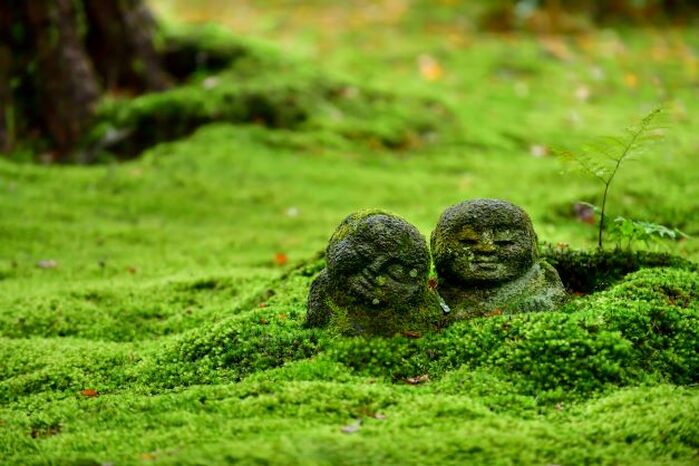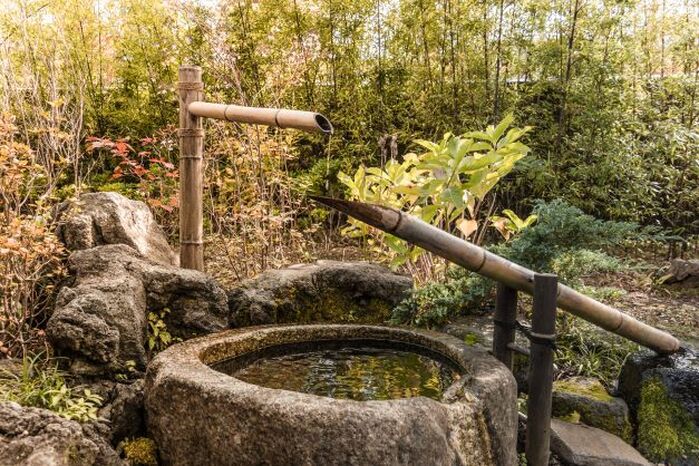|
This article contains affiliate links
There are very few garden styles which imitate and enhance the aesthetic qualities of the natural world.
Japanese gardens take the most dramatic elements of the natural world and condense them into remarkably beautiful spaces. Using a combination of landform, rocks, water, trees and plants they form landscapes of balance and tranquillity. Layered on to this backdrop, bold colours and textures can form interesting contradictions and contrasts. Combined with traditional, elements such as Lanterns and shrines these gardens saturate you in the very essence of Japan! There are very few who do not become completely seduced by the wonder of Japanese gardens. It‘s no surprise that every year thousands of people embark upon creating their very own Japanese themed garden. Consequently I have included 20 exciting Japanese garden ideas below, for some extra inspiration! 1. Create a moss garden
Japanese gardens are well known for their simulation of the natural world. Moss gardens have long been manicured to create microcosms of forests and green vegetation within the natural landscape. Moss thrives in Japans moist and humid climate and is regularly utilised within Japanese gardens. Moss is a great way to produce carpets of green vegetation in a damp, shady condition.
Image credit: T photography/Shutterstock.com
2. Utilise rocks & bouldersRocks and boulders can bring a whole new energy to a landscaped garden. This is particularly so if rocks are integrated with landform and positioned in a naturalistic arrangement. In Japanese gardens rocks are regularly used to symbolise mountains and cliffs. Elongated rocks are sometimes set into the ground vertically to add drama to the scene.
image credit: Sergii Rudiuk/Shutterstock.com
3. Plant for seasonal changeJapanese gardens approach the use of plants and flowers in a different way to western gardens. The Japanese typically utilise more evergreen planting so landscapes remain more visually balanced all year round. Flowering plants and colours are enjoyed more at a greater scale. This can be observed with their mass plantings of Japanese cherry blossom and flowering shrubs such as Rhododendron. When planting for colour, go for ‘shock and ore’ instead of small and singular flowering plants.
Image credit: Blanscape/Shutterstock.com
4. Japanese lanterns
Japanese lanterns have a long history within Japanese gardens. Originally lanterns were placed around Buddhist temples and Shinto shrines. The lanterns were placed along pathways and lit to symbolise spiritual guidance through darkness. As Japanese gardens regularly symbolise larger landscapes many Japanese lanterns took an architectural form. This was to display the beauty human craftsmanship and buildings within the landscape. For more specific information on traditional Japanese garden lanterns visit our resource here.
Image credit: Oregonez/Shutterstock.com
5. Build a fish pondJapanese gardens always seek to include the main elements of the wider, natural, landscape. This means water is regularly incorporated into landscape design. Historically, large ponds were incorporated into gardens to provide irrigation for crops and animals. Fresh water fish were also raised in large ponds to provide food. Large, colourful fish such as Koi are seen as good fortune and prosperity in Japan. Therefore, building your very own Koi pond can be a really fun Japanese garden idea.
Image credit: Paula Cobleigh/Shutterstock.com
6. Create Bonsai forms
Bonsai is an ancient art traditionally associated with Japanese gardens and culture. However, the concept of manipulating and enhancing natural forms is not restricted to Bonsai. The art of Niwaki involves the pruning and clipping of landscape trees to create a specific look or atmosphere. Generally the idea is to thin out the crowns of trees to allow the eye and ‘energy’ to pass through. The end result is garden trees with an extremely refined and a picture perfect ‘Bonsai form’.
Image credit: Atosan/Shutterstock.com
7. Crane ornamentsThe Crane has been celebrated in Japanese artworks and culture for many centuries. The legend of the ‘’Thousand cranes’’ involves Crane like entities granting of any wish. This has led to a cultural association of the Crane with peace, longevity and good fortune. Japanese gardens have an appreciation for such elegance within the natural world. Cranes are some of the most elegant and majestic creatures on earth displayed so well by this Crane ornament. 8. Create a Zen garden
Zen gardens are one of the most recognisable and popular, Japanese garden features. These gardens are instantly recognisable by their assortment of carefully positioned rocks and builders. Rocks and boulders are typically placed within levelled areas of gravel which are carefully raked to create a ‘ripple effect’. Such arrangements are said to represent natural features within the natural world such as mountains and water. Zen gardens are supposed to capture the energy of nature to evoke a feeling of meditative calm.
Image credit: Simon Minter/Shutterstock.com
9. Use evergreens
Japanese gardens have long been designed to look beautiful throughout the calendar. This has led to reliance upon the planting of evergreen plants. Evergreens allow a garden to maintain its planting structure throughout the year. This results in a more focused appreciation of seasonal change from flowering bulbs and flowering shrubs.
Image credit: CL TSAI/Shutterstock.com
10. Bamboo water features
Bamboo water features are a great way to incorporate the sound and movement of water into your garden. These water features resemble traditional Japanese ‘Shishi Odoshi’ or dear scares. These features were designed for tubes of bamboo to become filled with water. When full, the weight of water caused the bamboo to pivot downward and make a loud whacking sound. This scared wild animals such as deer away from agricultural crops and kept them away. What better way to add a traditional Japanese water feature into your garden?
Image credit: Shaun Robinson/Shutterstock.com
11. Plant groundcovers
Groundcovers are very commonly utilised in Japanese planting schemes. These low growing plants enable large areas of block foliage creating an undulating, carpet effect. This type of planting is very typical within Japanese gardens which help to create a contrast to vertical elements. Block ground covers can really draw attention to sculpted trees and structures within the landscape.
Image credit: EWY Media/Shutterstock.com
12. Utilise stepping stones
Stepping stones have been used traditionally to guide people through a garden space. Due to the mountainous and hilly nature of Japan defined walking pads were commonly formed. Stepping stones allowed for an obvious route up slopes and through areas of planting. These stones are often rustic and naturalistic in their appearance made from flat pieces of rock.
Image credit: pr2is/Shutterstock.com
13. Install screens
Screens have been associated with Japan both inside and out for many centuries. In Japanese gardens screens can be used to create privacy and screen bad views. Similarly, screens can also be utilised to frame specific views and create suspense as you travel through a space. Traditionally screens have been made with thin timber and paper. However, screens can also be constructed using more robust, external, grade, materials. There are also products on the market such as Bamboo screening which are perfect for Japanese gardens.
Image credit: mTaira/Shutterstock.com
14. Build a tea house
Also known as a Chashitsu, a traditional, Japanese tea house is an outside room specifically designed for tea ceremonies. These had openings and windows which framed majestic views of Japanese gardens. This allowed for connectivity with nature creating an atmosphere of peace and serenity. Many examples of tea houses are too large for the average garden. However, tea houses do not have to be large structures! Small shed sized tea houses can be created with a little investment and some DIY knowhow.
Image credit: Kris Hoobaer/Shutterstock.com
15. Create a meditation space
An important element within Japanese garden design is creating spiritual connection with the landscape. In traditional Japanese culture and philosophy nature is believed to clam the mind and create inner peace. This enables the soul to easily connect with feelings of contemplation and tranquillity. The peace and quiet of such spaces makes it easy for mindfulness practices such as meditation. Meditation spaces can be enshrouded in vegetation or face religious shrines or enchanting views.
Image credit: Guadalupe Polito/ Shutterstock.com
16. Plan for contrastIf you want to make a statement within your Japanese garden incorporate bold contrasts. Japanese gardens are well known for their juxtaposition and visual contradiction. This could be a red Acer surrounded by greenery or where moss meets light coloured gravels. When choosing your planting pallet try to match planting which will create bold contrasts.
Image credit: Unique Vision/ Shutterstock.com
17. Build raised platforms
Known as “Dai” in Japanese, raised platforms are used in a number of ways. Typically made of wood raised decks and walkways can provide a sense of separation and elevation from nature. Some raised walkways zig zag across the landscape to prevent evil spirits from following you on your path. Often however, raised platforms host vantage points over focal points or places with good views.
Image credit: Dirk Ercken/Shutterstock.com
18. Create dry river bedsJapanese gardens have always been effective at representing movement and natural processes within the landscape. By combining various elements such as soil, boulders, planting and water the rugged beauty of nature can be celebrated. There is probably no better example of this than dry river beds. These can create dramatic features of movement through a Japanese garden design.
Image credit: cgartdesigns/Shutterstock.com
19. Buddha ornaments
Buddha ornaments are often placed within Japanese gardens to add a cultural significance and feeling of peace and spirituality. Consequently, Buddha ornaments are strategically placed within locations of high spatial hierarchy. These can be on top of mounds, by water or within a man made temple or shrine. Ultimately depictions of Buddha are meant to bring an element of mindfulness and harmony to a garden.
Image credit: Roberto Cerruti/Shutterstock.com
20. Build a Pagoda
Pagodas have long been used to create bold focal points within Japanese gardens. These can be painted bright colours and adorned with cultural architecture or artwork. Pagodas can also be used to frame entrances or provide shelter to outdoor rooms. Building a bespoke Japanese style pagoda can be a great way to provide a Japanese garden with added drama and authenticity.
Image credit:Ken Wolter/Shutterstock.com
Thank you for reading our article on 20 exciting Japanese garden ideas. If you need help planning or building a Japanese garden, why not contact us. Below I have included some other Japanese garden articles you may find interesting.
'As an Amazon associate I earn from qualifying purchases'
0 Comments
Leave a Reply. |
The Author
|
Landscaping services across Buckinghamshire, Amersham, Aylesbury & High Wycombe
Hyde Heath, Amersham, Buckinghamshire |
|































